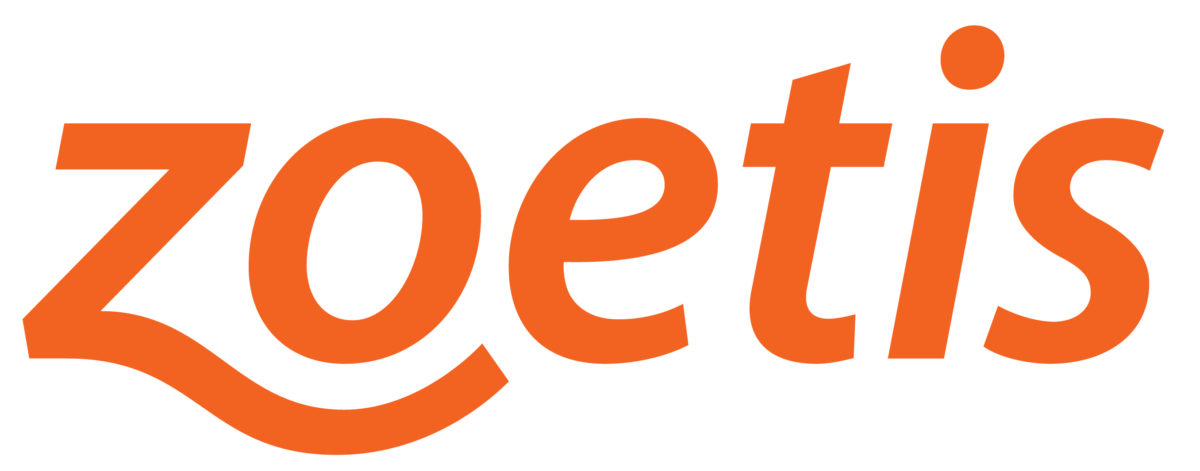Good herd management and a regular testing program will control Johne’s disease.
You CAN control Johne’s disease in a herd with two basic steps: stop new infections from occurring in calves and eliminate the source of infection. Control of Johne’s disease takes time and a strong commitment to management practices focused on keeping young calves away from contaminated manure, milk, water, etc. A typical herd clean-up program may take 5 years or 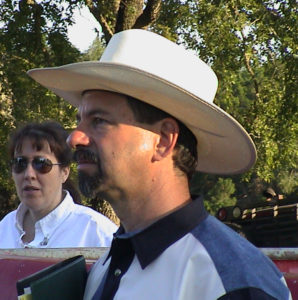 longer. Faster clean-up programs are possible, but they are usually more expensive. The basics of control are simple: new infections must be prevented, and animals with the infection must be identified and removed from the herd.
longer. Faster clean-up programs are possible, but they are usually more expensive. The basics of control are simple: new infections must be prevented, and animals with the infection must be identified and removed from the herd.
Below we explain more details. However, the best advice will come from your herd veterinarian who knows the specifics of your operation.
#1 Eliminate the MAP infection sources from your here by testing and culling infected cows
Two basic types of tests are available for Johne’s disease: tests focusing on the bacterium (MAP) in manure and tests for antibodies in blood using ELISA technology. PCR on manure samples is more sensitive than ELISA at detecting MAP-infected cattle, but the ELISA is faster and cheaper. Typically, ELISA is recommended for commercial cow-calf producers and PCR on manure samples is recommended for cattle breeders. For a comprehensive discussion of diagnostic tests readers should go to the diagnostics section of this site.
Annual testing of adult cattle in the herd permits an owner to find and cull the subclinical (i.e., still healthy, but MAP-infected) cows that are shedding the organism on the premises. Testing should be timed to happen shortly before calving seasons to insure that no test-positive animals are around newly born calves. If a whole herd test is not feasible, for a partial herd test sampling should focus on the older animals and those in poorer body condition.
#2 Cull off-spring of test-positive cows
Off-spring of test-positive cows are at risk for MAP-infection. Depending on the value of the animal and how aggressively you want to control Johne’s disease, culling of these animals may be advisable. They can be retained until market weight with minimal risk of MAP infection spread. They should NOT, however, be considered as good herd replacements.
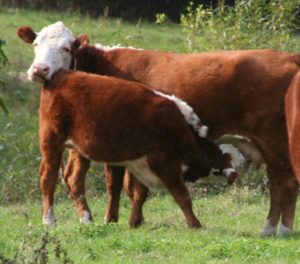 The rationale behind this is that MAP bacteria are excreted not only in feces but also directly into colostrum and milk and can also infect the unborn fetus. For beef cattle, in contrast to dairy cattle, transmission of MAP is more likely to occur from dam to off-spring given the time the cow-calf pair are together. Consequently, the highest risk of infection follows family lines: daughters of MAP-infected cows have a greater likelihood of being infected than do daughters of non-infected cows. So, herd owners wishing to make most rapid progress toward elimination of Johne’s disease from their herd will be well advised to cull daughters of ELISA- or PCR-positive cows starting with the last daughter born and working backwards in calving history.
The rationale behind this is that MAP bacteria are excreted not only in feces but also directly into colostrum and milk and can also infect the unborn fetus. For beef cattle, in contrast to dairy cattle, transmission of MAP is more likely to occur from dam to off-spring given the time the cow-calf pair are together. Consequently, the highest risk of infection follows family lines: daughters of MAP-infected cows have a greater likelihood of being infected than do daughters of non-infected cows. So, herd owners wishing to make most rapid progress toward elimination of Johne’s disease from their herd will be well advised to cull daughters of ELISA- or PCR-positive cows starting with the last daughter born and working backwards in calving history.
However, the calf rearing environment and management will greatly influence risk of infection. On operations where young calves are confined for longer times with infected adult cattle shedding MAP in their manure, the risk of transmission from adults to non-offspring calves can be significant.
#3 Correct herd and environmental management facilitating MAP transmission.
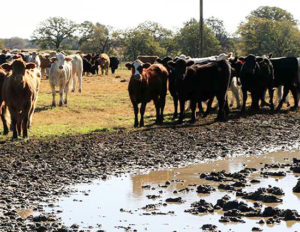 While working hard to control the infection, remember not to undo all your good work by re-introducing MAP. As discussed in the Prevention section, avoid bringing cattle into your herd from unknown sources. This can happen by leasing bulls, purchasing dairy cows (which have a higher incidence of Johne’s disease than beef cattle) for nurse cows, fertilizing pastures with manure from other herds (particularly dairy herds) or implanting a valuable embryo in a healthy-looking but MAP-infected recipient cow, who then produces an infected calf.
While working hard to control the infection, remember not to undo all your good work by re-introducing MAP. As discussed in the Prevention section, avoid bringing cattle into your herd from unknown sources. This can happen by leasing bulls, purchasing dairy cows (which have a higher incidence of Johne’s disease than beef cattle) for nurse cows, fertilizing pastures with manure from other herds (particularly dairy herds) or implanting a valuable embryo in a healthy-looking but MAP-infected recipient cow, who then produces an infected calf.
Here are some specifics:
- Ponds that drain contaminated pastures may harbor MAP for over a year and are very potent means of infection spread and so they should be fenced off. Clean well water in clean stock tanks should be provided. If manure-contamination of water troughs occurs, be aware when cleaning the troughs that the organism collects in the sediment. Don’t just dump it on the ground; discard it away from calves.
- Over-crowding in wet muddy lots should be avoided, particularly during calving season. If cattle are gathered up for calving, the pasture, calving pens and the cows should be kept as clean and dry as possible. Dam and newborn calf should be removed from the calving area to a lower risk environment as soon as possible.
- Some producers set up hutches to shelter calves during bad weather. The hutches are small enough to allow the calves to enter but too small for cows, limiting the build-up of and exposure to potentially MAP-contaminated adult manure.
- Move your mineral feeder away from water sources, reducing congestion and heavy manure contamination in the drinking area.
- Hay bales/rolls for winter feeding should be placed in different sites to prevent accumulation of contaminated feces in one area (areas which are often congregation sites for susceptible calves).
- Grazing contaminated pastures is a possible means of infection transmission. Adult animals are at low risk for becoming infected by this route. Till contaminated pastures and wait for time and environmental conditions (repeated changes in temperature, minimize shaded soil by cutting grass/crops/shrubs) to kill off MAP on fields. While a majority of the organisms die within three months, a small population can remain for up to a year. Put off stocking contaminated pasture with young animals as long as feasible.
#4 Calf management
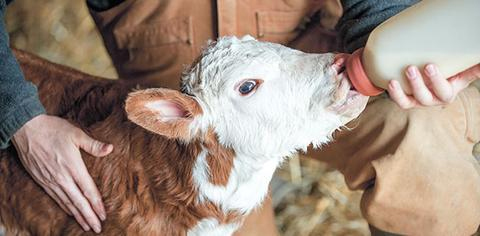 For dairy herds, artificial rearing of calves is one of the most effective paratuberculosis control methods. This technique is rarely an option for cow-calf operators, but some small herds try hand rearing with clean colostrum and milk replacer for a few select calves. However, there’s a good chance that the calf was born infected if the dam is test-positive.
For dairy herds, artificial rearing of calves is one of the most effective paratuberculosis control methods. This technique is rarely an option for cow-calf operators, but some small herds try hand rearing with clean colostrum and milk replacer for a few select calves. However, there’s a good chance that the calf was born infected if the dam is test-positive.
Prevention is far more cost-effective than control after infection. If herds are infected, a steady consistently applied control program will succeed and potentially eradicate the MAP infection. The foundation of a Johne’s control program in cow-calf operations is a test-and-cull plan.
#5 Special circumstances with bulls and valuable cows.
Valuable cows.
To “rescue” the genetics of valuable cows, embryo transfer is considered a safe means of producing non-infected calves from infected cows. Thorough embryo washing is required and careful selection of paratuberculosis-free recipients is a must.
Bulls.
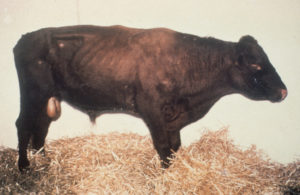 Purchase of MAP-infected bulls should be avoided by requesting the Johne’s disease herd test history from bull owners. These bulls present much more of a risk through their MAP-contaminated manure vs. their MAP-contaminated semen. Although MAP has been cultured from bovine semen, few if any cases of breeding-transmitted MAP infections have been documented. Exclusive use of artificial insemination is the only alternative.
Purchase of MAP-infected bulls should be avoided by requesting the Johne’s disease herd test history from bull owners. These bulls present much more of a risk through their MAP-contaminated manure vs. their MAP-contaminated semen. Although MAP has been cultured from bovine semen, few if any cases of breeding-transmitted MAP infections have been documented. Exclusive use of artificial insemination is the only alternative.

